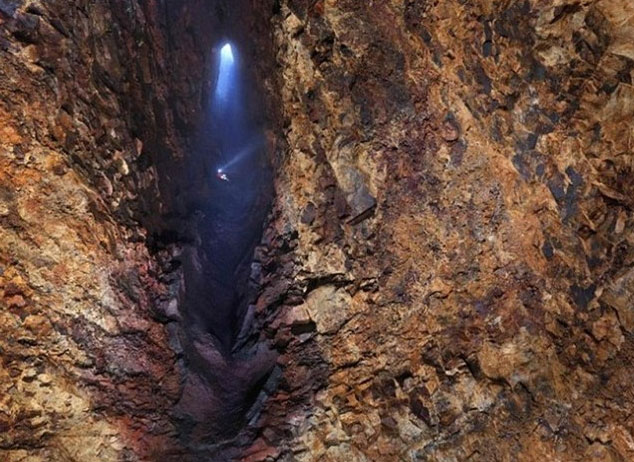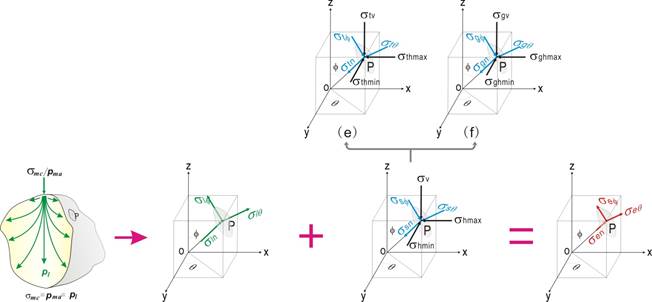
The magma chamber of Thrihnukagigur volcano,Iceland
Liquid-driven fractures in the elastic upper crust, upper mantle, and throughout the entire lithosphere are fundamental to the transport and emplacement of melt. These liquid-driven fractures also are fundamental to the migration of metamorphic fluid, and to the formation of vein- and veinlet-associated mineral deposits. Studies on the formation mechanism of liquid-driven fractures involve origin of force and fracturing mechanism. The force that allows liquid to create and propagate these fractures has been hypothesized to be due to a large number of causes, such as the buoyancy, pressure induced by phase changes from rock to melt, dilatation caused by large variations in temperature and pressure, pressure induced by K-metasomatism, internal vapor pressure related to retrograde boiling and overpressure related to volatile concentration in the residual melt. However, some models are suitable for special conditions and geological settings.
There are two types of fluid-driven failure models. The first model assumes that fluid-driven fractures form when the magnitude of the fluid pressure is bigger than that of the applied minimum normal principal stress (compressive stresses are positive) plus the tensile strength of the rock. The second model is referred to as the Hubbert-Willis's model or the hydrofracturing model and imagines a stress distribution around a circular hole that contains with an internal pressure within the middle of an infinite elastic plate that is submitted to two far-field stresses. However, both these two models do not completely simulate reality when compared carefully to observations.
On the basis of general mechanic properties of confined liquid in relation to rock mechanic features of the lithosphere and natures of liquid-driven fractures in the crust, prof. Dr. Xing-Wang Xu and his group of the division of solid mineral resources, institute of Geology and Geophysics, CAS, suggested that a confined liquid in the elastic lithosphere has the potential to transmit a maximum applied compressive stress. This stress can be transmitted to the internal contacts between rock and liquid and would then be transformed into a normal compressive stress with tangential tensile stress components. During this process, both effective compressive normal stress and tensile tangential stresses arise along the liquid-rock contact. They proposed a new principal for liquid-driven fractures in the lithosphere.
The new principal suggests that a confined liquid in the elastic lithosphere has the potential to transmit a maximum applied compressive stress. A confined liquid receives the maximum applied pressure (pma) that is equal to the maximum compression stress (smc) from the rock that surrounds it. This stress can be transmitted to the internal contacts between rock and liquid and would then be transformed into a normal compressive stress with tangential tensile stress components. During this process, both effective compressive normal stress and tensile tangential stresses arise along the liquid-rock contact. When the magnitude of the minimum effective tensile tangential stress is larger than the tensile strength of the surrounding rocks, liquid-driven fractures develop. Liquid-driven fracture initiates at the point along the rock-liquid boundary where the maximum compressive stress is applied and propagates along a plane that is perpendicular to the minimum effective tensile tangential stress and also is perpendicular to the minimum principal stress. The minimum depth for liquid-driven fracture, which is induced by a spherical confined liquid and an isolated magma chamber in the elastic lithosphere, ranges from 2 to 6 km, whereas dikes with hemi-cylinder-shaped ends propagate upwards closer to the surface under gravity.
When two magma chambers are connected by a conduit, melts and pressure are transported and transmitted from the high-pressure chamber to the low-pressure chamber. This transmitting mechanism causes pressure in the intermediate chamber to rise and also causes effective normal and tangential stresses to increase. This results in the propagations of dikes and the re-transportation of stagnated and partially crystallized magma into intermediate- or shallow magma chambers. Tectonic stress alters local stress fields in the surrounding country rocks and therefore synchronously varies the local effective tensile tangential stress and the nature and geometry of the liquid-driven fractures.
The new principal shows us the reason for some important and common geologic phenomena, such as how do denser basaltic magmas come to the surface? Why some magma halt in the middle crust to form batholiths while others can move up to shallow cover to produce porphyries or to the surface to form volcanic rocks? Why magmas in chamber under volcano can restart to ascent after crystallization for a long period? Why kimberlite and associated diamond are only present in some old, cold (strong) and thicker continent? Why do shallow magma chamber form at a depth about 2.0- 6.0 km?
This research is supported by the NSFC (Grants 41390422 and 41072060), the CAS Knowledge Innovation Project (Grant Numbers kzcx-ew-ly03 and kzcx2-yw-107) and the National 305 project (Grant number 2011BAB06B03-3).

Fig. 1 Sketch of model showing elastic stress transmission and transformation by confined liquid

Fig. 2 Schematic model showing formation and transmission of pumping pressure and melt transport in the elastic lithosphere under the gravity setting
Contact:
XU Xingwang
Division of Solid Mineral Resources, IGGCAS
E-mail: xuxw@mail.igcas.ac.cn